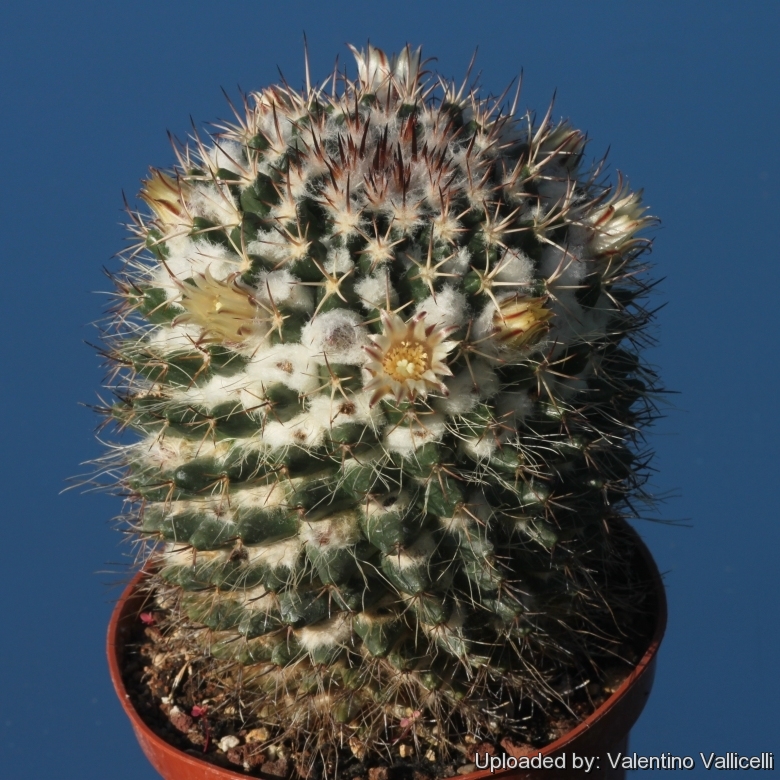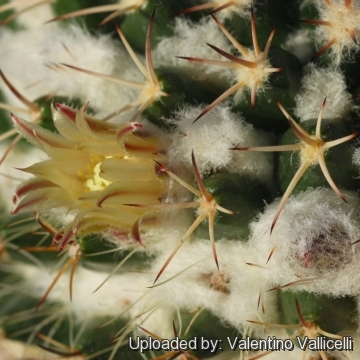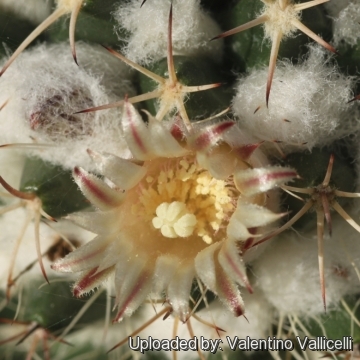Accepted Scientific Name: Mammillaria voburnensis Scheer
London J. Bot. 4: 136. 1845

Cactus woburnensis (Mammillaria voburnensis) Photo by: Valentino Vallicelli
Synonyms:
See all synonyms of Mammillaria voburnensis
Description: Mammillaria voburnensisSN|20736]]SN|25920]] (Sometimes wrongly spelled “woburnensis”), is a freely clustering cactus with yellow 'snowy' tomentum near the top. This species forms mounds up to 30 centimetres high and wide. It was firstly described in 1845 by Frederick Scheer.
Habitat: Solitary or growing in large clumps of 25 or more, but loosely held together up to 30 cm high and wide, giving off new plants from all parts of the body.
Stems: Globose to cylindrical, apex convex, 5-15 cm high and about 3 cm in diameter (often larger in cultivation), yellowish green to dull green with a reddish tinge, oozing abundant milky sap if enjured.
Tubercles: Small, sub-ovoidal, wider at base, face polyhedral above, rounded below, dull green often reddish toward the top, with latex. Axills densely filled with silky wool and bristles. Tubercle arranged in 8-13 spirals.
Areoles: Woolly becoming soon bare as they ages.
Radial spines: 5-9 (approx 4 mm long) sub-equal, irregularly spreading, more or less recurved, lower 4 slightly longer, yellowish or ivory white pointing downwards. All yellowish or ivory white.
Central spines: 1-2(rarely more), subulate to awl shaped, rigid, upright, stiff, 1-2 two times longer than radials (approx 12 mm long) at fist brown, brownish-red or yellow, becoming ivory-brown.
Flowers: Yellowish with a reddish tinge, small, about 1 cm long..
Fruits: Club shaped red18 to 25 mm long.
Seeds: Minute brown.
Related species: Mammillaria voburnensisSN|25920]]SN|25920]] is strictly related with Mammillaria karwinskianaSN|25920]]SN|20736]] and often synonymized with the latter.
Subspecies, varieties, forms and cultivars of plants belonging to the Mammillaria voburnensis group
Bibliography: Major references and further lectures
1) Frederick Scheer “A Brief Description of a New Species of Mamillaria in the Royal Botanic Gardens of Kew - Mamillaria Voburnensis, Scheer.” London Journal of Botany. 4:136–137, 1845.
2) David Hunt, Nigel Taylor “The New Cactus Lexicon” DH Books, 2006
3) David Hunt Mammillaria Postscripts. 9: 11, 1997.
4) Monatsschrift für Kakteenkunde.18(5): 65–66,1908.
5) Edward F. Anderson “The Cactus Family” Timber Press, 2001
6) John Pilbeam “Mammillaria The Cactus File Handbook” Nuffield Press. 1999.
7) James Cullen, Sabina G. Knees, H. Suzanne Cubey “The European Garden Flora Flowering Plants: A Manual for the Identification of Plants Cultivated in Europe, Both Out-of-Doors and Under Glass”Cambridge University Press, 11/August/2011
8) Nathaniel Lord Britton, Joseph Nelson Rose “Cactaceae: Descriptions and Illustrations of Plants of the Cactus Family” vol. 4 The Carnegie Institution of Washington, Washington 1923
9) Ulises Guzmán, Salvador Arias, Patricia Dávila “Catálogo de cactáceas mexicanas. Universidad Nacional Autónoma de México”, Mexiko-Stadt 2003.
 Cactus woburnensis (Mammillaria voburnensis) Photo by: Valentino Vallicelli
Cactus woburnensis (Mammillaria voburnensis) Photo by: Valentino Vallicelli Cactus woburnensis (Mammillaria voburnensis) Photo by: Valentino Vallicelli
Cactus woburnensis (Mammillaria voburnensis) Photo by: Valentino VallicelliCultivation and Propagation: Mammillaria voburnensisSN|25920]]SN|25920]] is relatively easy to cultivate, and makes interesting specimens for any collection. It grows by producing offsets and doesn't require any special treatment.
Growth rate: Slow to offset and basically slow. Over time it will produce large clumps.
Exposure: It needs as much light as possible without burning the plant, to keep the stems compact.
Soil: It needs a well-drained soil mix.
Watering: Water well and then allow to dry thoroughly before watering again, during the growing season. Should really get no water in the winter
Hardiness: From tropical countries and pretty cold sensitive (listed most places as 10b-11, but seems to do OK in 10a). It can however can survive short exposures to light freezing temperatures (-4° C.) if properly hardened off and kept dry.
Propagation: It is best propagated from seed. Seed readily germinates at 20°-22°C, or by offsets if available.













